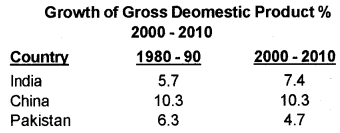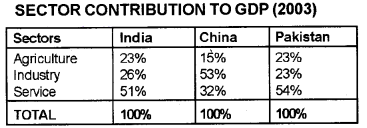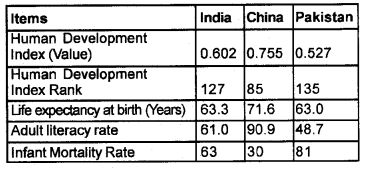Kerala Plus One Economics Chapter Wise Questions and Answers Chapter 10 Comparative Development Experience of India with its Neighbours
Plus One Economics Comparative Development Experience of India with its Neighbours One Mark Questions and Answers
Question 1.
The system in which people collectively cultivated land in China is known as.
Answer:
Commune System.
Question 2.
Which of the following countries has the highest population growth rate?
(i) India
(ii) China
(iii) Pakistan
Answer:
(iii) Pakistan
Question 3.
In which year, China announced its first five-year plan?
(i) 1950
(ii) 1951
(iii) 1952
(iv) 1953
Answer:
(iv) 1953
Question 4.
India introduced economic reforms in _______ .
(i) 1990
(ii) 1991
(iii) 1993
(iv) 1995
Answer:
(ii) 1991
Question 5.
Chinas great leap forward was in the year ______ .
(i) 1953
(ii) 1958
(iii) 1978
(iv) 1991
Answer:
(ii) 1958
Question 6.
Commune system is the feature of
(i) India
(ii) China
(iii) Pakistan
(iv) All the above
Answer:
(ii) China
Question 7.
Reforms in ……………… were introduced in 1978. (China, Pakistan, India)
Answer:
China
Plus One Economics Comparative Development Experience of India with its Neighbours Two Mark Questions and Answers
Question 1.
The table shows the growth of crops domestic product of India China and Pakistan.

State two reasons why Pakistan’s growth rate declined compared to two other countries.
Answer:
Political instability, over-dependence on remittance and foreign aid along with volatile performance of agricultural sector are the reasons for Pakistan’s decline in economic growth.
Question 2.
Write the full form of the following.
- SAARC
- ASEAN
Answer:
- SAARC – South Asian Association for Regional Co-operation.
- ASEAN – Association of Southeast Asian Nations.
Question 3.
Evaluate the various factors that led to rapid economic development in China.
Answer:
Great leap forward, commune system, privalisation, reforms, foreign direct investment, etc were the factors that led to rapid economic development of China.
Question 4.
Name the SAARC nations.
Answer:
- India
- Pakistan
- Nepal
- Bhutan
- Bangladesh
- Maldives
- Srilanka
Question 5.
Mention some examples of regional and economic grouping.
Answer:
Some regional and economic grouping are:
- SAARC
- European Union
- ASEAN
- G-8
- G-20
Plus One Economics Comparative Development Experience of India with its Neighbours Three Mark Questions and Answers
Question 1.
Give the basic feature of an underdeveloped economy.
Answer:
Over-dependence on agriculture, large population growth and low income, large poverty and unemployment are the basic features of underdeveloped economies.
Question 2.
State whether true or false
- in India, agriculture is the largest contributor to GDP
- in china, industry is the largest contributor to GDP
- compared to India and Pakistan, China has the highest rank in HDI.
Answer:
- False. In India, services sector is the larges contributor to GDP
- True
- True
Question 3.
Mention the various indicators of Human Development Index.
Answer:
- Per capita income
- Adult literacy
- Life expectancy
Question 4.
Mention the years when first five-year plan was initiated in India, China, and Pakistan.
Answer:
- China – 1978
- Pakistan – 1989
- India – 1991
Question 5.
Prepare a table showing demographic indicators of India, China and Pakistan.
Answer:

Question 6.
Group the following features pertaining to the economies of India, China, and Pakistan under three heads One child norm, low fertility, high degree of urbanization, mixed economy, very high fertility rate, large population, high density of population, growth due to manufacturing sector, growth due to service.
Answer:
1. Economy of India:
- High density of population
- Growth due to service sector
2. Economy of Pakistan:
- Mixed economy
- Very high fertility rate
3. Economy of China:
- One child norm
- Low fertility
- High degree of urbanization’
- Large population
- Growth due to the manufacturing sector
Question 7.
Prepare a note on the ‘Great Leap Forward’ of China.
Answer:
The Great Leap Forward (GLF) campaign initiated in 1958 aimed at industrializing the country on a massive scale. People were encouraged to set up industries in their backyards. In rural areas, communes were started. Under the Commune system, people collectively cultivated lands.
In1958, there were 26,000 communes covering almost all the farm population. GLF campaign met with many problems. A severe drought caused havoc in China killing about 30 million people. When Russia had conflicts with China, it withdrew its professionals who had earlier been sent to China to help in the industrialization process.
Question 8.
Mention the salient demographic indicators of China, Pakistan and India.
Answer:
The population of Pakistan is very small and is about one-tenth of China and India:
Though China is the largest nation among the three, its density is the lowest. Population growth is highest in Pakistan, followed by India and China. Sex ratio is low and biased against females in all three countries.
The fertility rate is also low in China and very high in Pakistan. Urbanization is high in both Pakistan and China with India having 28 percent of its population living in urban areas.
Question 9.
Give the similarities of the development path India, China and Pakistan.
Answer:
India, China and Pakistan had adopted economic reforms for economic development. Five Year Plans were initiated in these countries as development strategy. Agriculture plays an important role in the economic development in these nations.
Plus One Economics Comparative Development Experience of India with its Neighbours Four Mark Questions and Answers
Question 1.
Match column A with column B
| A | B |
| Great Proletarian Cultural Revolution | 1978 |
| Great Leap Forward (GLF) | 1991 |
| Economic reforms in India | 1953 |
| Economic reforms in Pakistan | 1965 |
| Economic reforms in china | 1951 |
| China’s first five-year plan | 1958 |
| India’s first five-year plan | 1988 |
Answer:
| A | B |
| Great Proletarian Cultural Revolution | 1965 |
| Great Leap Forward (GLF) | 1958 |
| Economic reforms in India | 1991 |
| Economic reforms in Pakistan | 1988 |
| Economic reforms in china | 1978 |
| China’s first five-year plan | 1953 |
| India’s first five-year plan | 1951 |
Question 2.
China’s rapid industrial growth can be traced back to its reforms in 1978. Do you agree? Elucidate.
Answer:
Yes, China’s rapid industrial growth can be traced back to its reforms in 1978. this is because reforms in agriculture and establishment of infrastructure in the areas of education and health, land reforms, etc. had been taking place with the introduction of reforms.
In the initial phase, reforms were initiated in agriculture, foreign trade, and investment sectors. In the later phase, reforms were initiated in the industrial sector. Private sector firms and township and village enterprises were allowed to produce goods.
The reform process also involves dual pricing:
It was found that establishment of infrastructure in the areas of education and health, land reforms, long existence of decentralized planning and existence of small enterprises had helped positively in improving the social and income indicators in the post-reform period. In short, it can be concluded that China’s rapid industrial growth can be traced back to its reforms in 1978.
Plus One Economics Comparative Development Experience of India with its Neighbours Five Mark Questions and Answers
Question 1.
Compare and contrast India, China and Pakistan’s sectoral contribution towards GDP in 2003. Draw inferences.

Answer:
The table given above shows the sectoral contribution of India, China, and Pakistan towards GDP. It can be seen from the table that in both India and Pakistan, the contribution of agriculture to GDP is the same, at 23 percent, but the proportion of workforce that works in this sector is more in India. In Pakistan, about 49 percent of people work in agriculture whereas in India it is 60 percent.
The sectoral share of output and employment also shows that in all the three economies, the industry and service sectors have less proportion of workforce but contribute more in terms of output. In China, manufacturing contributes the highest to GDP at 53 percent whereas in India and Pakistan; it is the service sector that contributes the highest. In both these countries, service sector accounts for more than 50 percent of GDP.
In the normal course of development, countries first shift their employment and output from agriculture to manufacturing and then to services. This is what is happening in China as can be seen from Table. In both India and Pakistan, the service sector is emerging as a major player of development. It contributes more to GDP and, at the same time, emerges as a prospective employer.
Question 2.
Compare the development of China, India, and Pakistan with respect to some salient human development indicators.
Answer:
The following table shows some of the salient features of China, India, and Pakistan with respect to human development indicators.

It can be found that the HDI index and value are much better in China compared to India and Pakistan. That is China is ahead of India and Pakistan on many human development indicators. Similarly, the life expectancy rate is higher in China compared to India and Pakistan.
In India and Pakistan, the life expectancy rate is almost similar that is 63 years. Adult literacy rate is very high in China and the infant mortality rate is comparatively lower. Thus China has made a better development in respect of HDI compared to India and Pakistan.
